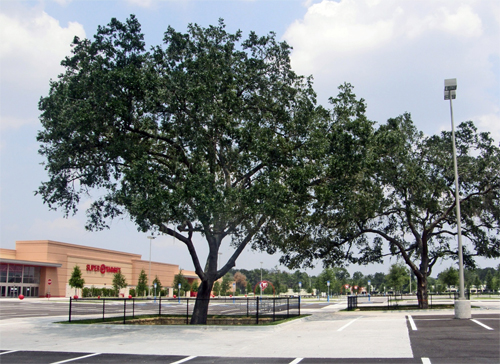LEED Points
A Pervious Concrete Parking Area may add LEED points to a project by building with a sustainable material, managing storm water, reducing ground water pollution from parking lots, accommodating trees, reducing irrigation needs and reducing energy used in air conditioning. Note this Target Super Center. LEED points are used as certification criterion to determine the level of sustainability of a project and its impact on the environment.

What are LEED points?
An association called the U.S Green Building Council is a coalition of pioneers from every sector of the construction industry working to create projects with a significant positive impact. The Association serves as a third party to certify projects to meet a defined criteria. More than 9,000 member organizations are thus creating buildings, building sites and communities to improve the quality of life. They do this using designs, materials and methods that improve the environment where possible and limit the negative impact of construction.
A U.S. General Services Administration Website describes the LEED program as a sustainable design program which has as it goals, to:
- Optimize site potential;
- Minimize non-renewable energy consumption;
- Use environmentally preferable products;
- Protect and conserve water;
- Enhance indoor environmental quality; and
- Optimize operational and maintenance practices.
- Sustainable Design Program
The advantage to everyone involved in a LEED certified project:
- Lower energy, operating costs
- Appreciate of the project in value;
- For occupants – boosts productivity;
- Provides a healthier working or living environment;
- May qualify for tax rebates, zoning allowances and other incentives in hundreds of cities and counties;
- Demonstrates an owner’s commitment to environmental stewardship and social responsibility;
- For the community – it will reduce loads on utilities, produce pleasant looking structures and projects and enhance high property values;
- For the globe – it reduces the heat island effect of urban development – and lowers air conditioning costs and impact;
- It meets governmental GSA requirements for rentals or sales to governmental entities;
- Reduces pollution – lowers the carbon footprint;
- It limits dependence on non renewable resources by creating sustainable, low maintenance, projects;
- For residential construction LEED certified homes will probably also qualify for the Energy Star ratings, which can qualify the buyer for a larger mortgage based upon reduced energy costs. Fannie Mae through its Green Mortgage Initiative offers such mortgage loans.
Projects registered with the LEED U.S. Green Building Council are evaluated against performance benchmarks including reduced operating costs, creating healthy environments and conserving natural resources. LEED certified receive a silver, gold or platinum certification.
Though Pervious Concrete is a recognized Green Building Product it alone does not create LEED certification. However the following LEED credits under the LEED rating system, LEED Credit 2.2 may apply to the use of Pervious Concrete. Other LEED Credit possibilities include but are not limited to the subjects below:
- LEED Credit SS-3 Brownfield Redevelopment
- LEED Credit SS-5.1 Site Development – Protect or Restore Habitat
- LEED Credit SS 5.2 – Maximize Open Space
- LEED Credit SS-C6.1 Stormwater Design – Quantity Control
- LEED Credit SS-C6.2 Stormwater Design – Quantity Control
- LEED Credit SS-C7.1 Heat Island Effect – Non-Roof
- LEED Credit WE C1.1 Water Efficient Landscaping
- LEED Credits MR-C4.1 AND MR-C4.2 Recycled Content
- LEED Credit MR-C5.1 AND MR-C5.2 Regional Materials
To contact someone about LEED info please use the e-mail address leedinfo@usgbc.org.
LEED certification is gaining importance every day. Though the bloom of green culture has been somewhat dampened by the economy, the economics of green building are still driving acceptance. Even though LEED certification may not be practical with all commercial building today, the economics of compliance with at least some of the LEED certification components will grow as a driving force. And Pervious Concrete will be a factor of growing importance!
Links for more information:
- USGBC – Project Certification
- Portland Cement Association (PCA) – LEED Certification
- Ready Mixed Concrete Industry – LEED Reference Guide Update (PDF)
- Pervious, Porous Concrete Pavement Economic Benefits
- As seen in Concrete InFocus – Using Pervious Concrete to Earn LEED Points (PDF)
- NRMCA – Using Pervious Concrete to Achieve LEED Points (PDF)
- RESNET – Energy Efficient Mortgage – Fannie Mae and NAHB Announce Environmental Partnership
